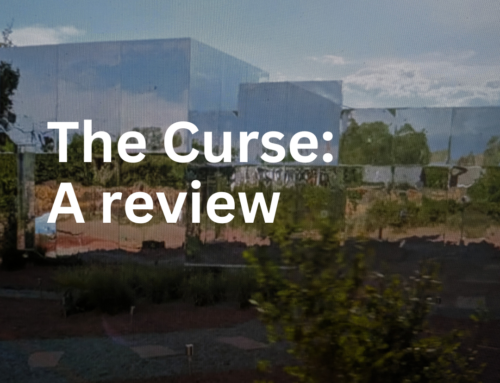Cost-Effective Passive House
Single-Family Homes in California
By Allen Gilliland, CEO, One Sky Homes
Introduction
I have been designing and building Passive Houses in the San Francisco Bay Area with my colleagues for over a decade. Our successful design/build company, One Sky Homes, won a Housing Innovation award from the Department of Energy and special recognition from the California Energy Commission for designing and building the first Zero Energy Home certified in California almost a decade ago – a Passive House. So my colleagues and I have lots of practical, hands-on experience both as designers and builders of custom single family Passive Houses.
We were “green” builders in the early 2000’s, racking up lots of points on green checklists but we wanted to up our game to design and build Zero Energy Homes starting in 2007, and eventually Zero Emissions Homes by 2014. We discovered Passive House (PH) principles and methods and have been developing and applying them to custom Zero Energy/Zero Emissions home projects ever since.
After a decade of implementing these principles and methods, we have found them to be simple, to add very little cost to a project and to deliver a superior building. Here I will explain the methods, costs and benefits in detail from an experienced custom homebuilder’s perspective. All cost data is taken directly from detailed project accounting over our last five projects, updated to reflect current costs as of 2020.
Easy
The good news is it’s not complicated. The essence of a Passive House is a super-insulated, air-tight building envelope with fresh air supplied by a Heat Recovery Ventilation system (HRV). There are only four basic building components to upgrade: insulation, windows, air barrier, ventilation. That’s it. While conventional building still does not pay enough attention to optimizing these key components, and there is a learning curve to climb, PH upgrades are straightforward. After all, how complicated can adding insulation be?
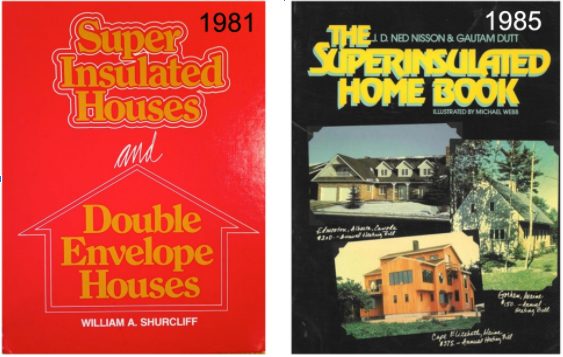
By the way, it is worth noting that Passive Houses and the underlying building science principles have been around for over forty years. They were called Super-Insulated Houses back then. (See a complete historical review going back centuries!)
Four Components
While Passive House can seem complicated, when you drill down you can see it four basic integrated parameters – better insulation, windows, air barrier and ventilation is all it takes to create a Passive House. There is a learning curve to climb to optimize design and construction with these four upgraded elements, but with experience it is easy.
1. Insulation
Current building code in California does not require foundation insulation and only R15/R30 insulation for walls and ceiling/roof respectively in our Bay Area climate zone. We upgrade insulation as follows: R12 EPS foam underneath and min. R10 at the perimeter of the foundation; 2×6@24”oc advanced wall framing to get R21 insulation in the cavity with 2” R8 rigid insulation over the exterior sheathing; R48 dense-pack fiberglass in min. 12” roof rafter cavities with a 2×4 over-frame to add 2” R8 rigid insulation. The line-item cost details are below in the Appendix but in summary, this adds less than 2% to the total project cost.
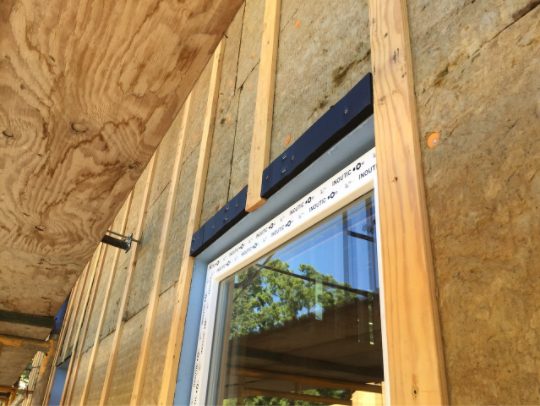
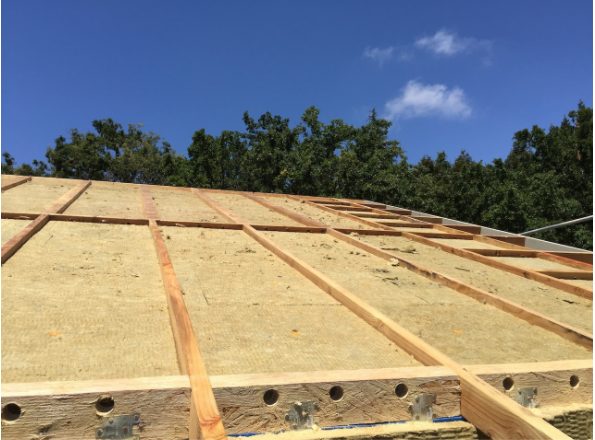
2. Windows
Glazed openings are the weakest component in the thermal envelope as typical double pane windows have an installed R-value of less than 3. We upgrade windows to triple pane glazing with better than code standard frames, which adds 15 to 20% to window cost but doubles R-values improves acoustics and thermal comfort. While challenging to source ten years ago, better framed triple-pane windows are easy to source today and the upgrade adds less than one percent to project cost.
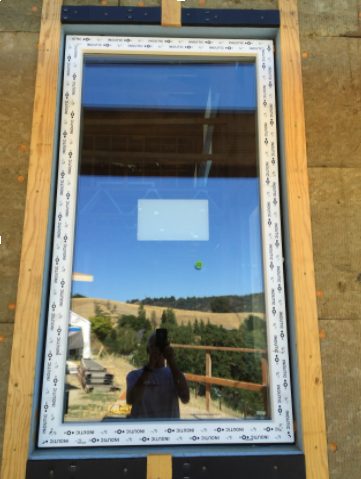
3. Airbarrier
Building codes are beginning to pay more attention to airtightness since thermal energy is easily lost by unwanted infiltration/exfiltration of air through a leaky envelope. This is building science 101 and airtightness is, therefore, a major focus of Passive House principles. Designing and installing an effective air barrier layer in the building envelope is important, but with experience, it’s very easy.
We use an off-the-shelf, lumber-yard-supplied, peel-and-stick air/weather barrier membrane to control both air leakage and moisture intrusion. The material costs more than standard sheet membranes but is an order of magnitude more effective. This upgrade increases project cost by 1/10th of one percent.
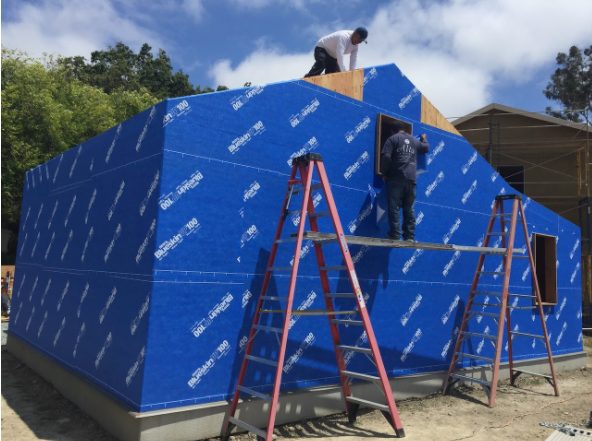
4. Ventilation
With an airtight building, continuous fresh air must be supplied to the interior. This has been a standard building code requirement for at least a decade and is referred to as ASHRAE Standard 62.2. However, this very basic standard can be met with one continuously running bathroom exhaust fan in a four-bedroom, 4 bath home where there is no controlled and filtered source of fresh air. It comes in through the leaky parts of the building and all the thermal energy is lost in the exchange. This is dumb, inefficient, and unhealthy.
Passive Houses use a central Heat Recovery ventilation system that ensures:
1) continuous, balanced, filtered fresh air supply and exhaust;
2) fresh air delivery to every room;
3) continuous exhaust from all bathrooms for moisture control;
4) retention of over 80% of the heat energy in the continuous air exchange.
There are lots of HRV manufacturers and configuration options today with varying costs and performance profiles. Whole-house HRV systems can be sourced for $1,000 or less while premium systems from Europe …where building ventilation has been more important for decades …are several thousand dollars. We still install premium European systems because the cost differential is not significant in our market, we trust the manufacturers, we control costs through innovative ducting design, and our customers rave about the indoor air quality. This adds 0.3% to project costs while delivering a tangibly superior living experience. The homeowners feel the difference.
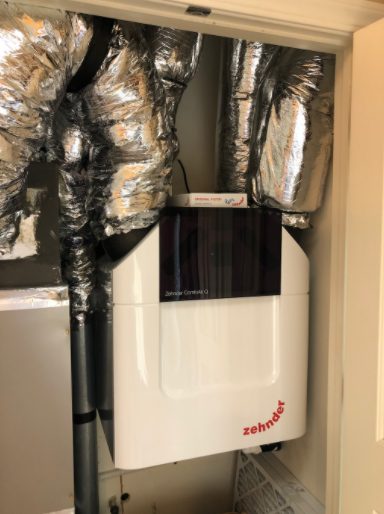
Superior Results
By implementing these four simple upgrades to baseline code performance, our Passive Houses deliver much better quality than standard buildings. Here is a list of the basic features and characteristics that make them superior.
Indoor Air Quality
This is number one on my list since there is nothing more important than the health of the family living in the building. When you experience abundant, fresh filtered air 24/7 inside a home it will spoil you forever. We have clients with respiratory conditions who reported significantly better breathing and sleeping after just a few days living in their new Passive House.
Thermal Comfort
With an air-tight, comprehensively insulated building envelope featuring triple pane windows there are no cold surfaces or drafts anywhere inside the building. Interior air and surface temperatures are constant and even throughout, including between multiple floors. This creates a distinct feeling of comfort for the occupants.
Acoustical Comfort
A PH building envelope effectively blocks exterior noise and creates a quiet interior that promotes a relaxed, serene indoor environment.
Energy Efficiency
Heating and cooling costs are dramatically reduced in Passive Houses. During the cooling season interior temperatures are not sensitive to exterior peak daytime temperatures. So it is easy to schedule cooling system operation for non-peak hours when electricity cost and carbon content are low, while not sacrificing comfort.
Resilience
Passive Houses maintain relatively comfortable interior temperatures even in the absence of mechanical systems. Occupants can easily and safely survive extreme weather events and extended power outages even in the more extreme climate zones.
Durability
The superior envelope protects the building structure, particularly from moisture-related damage over the long run. Passive Houses can expect a 100 year plus average life cycle.
Cost-Effectiveness
We’ve captured our costs for a decade’s worth of projects and share them here below, as a fully transparent testament to the claims we’ve made above. Table 1 summarizes the PH cost increment for custom residential homes in the Bay Area while Table 2 shows the line item detail. (click on Table 2 to get readable pdf)
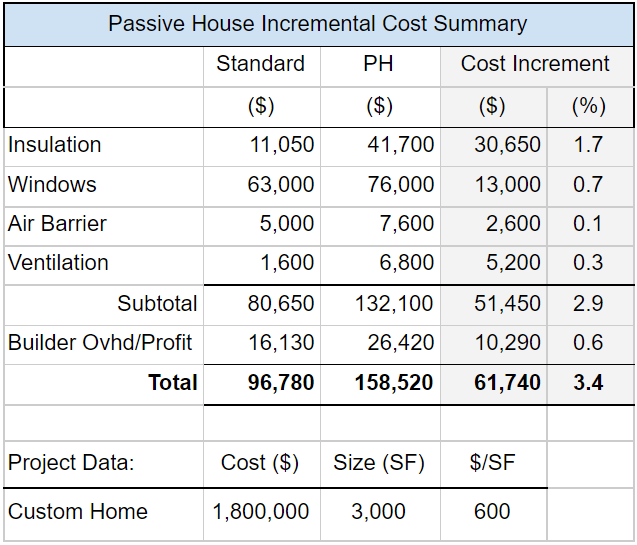
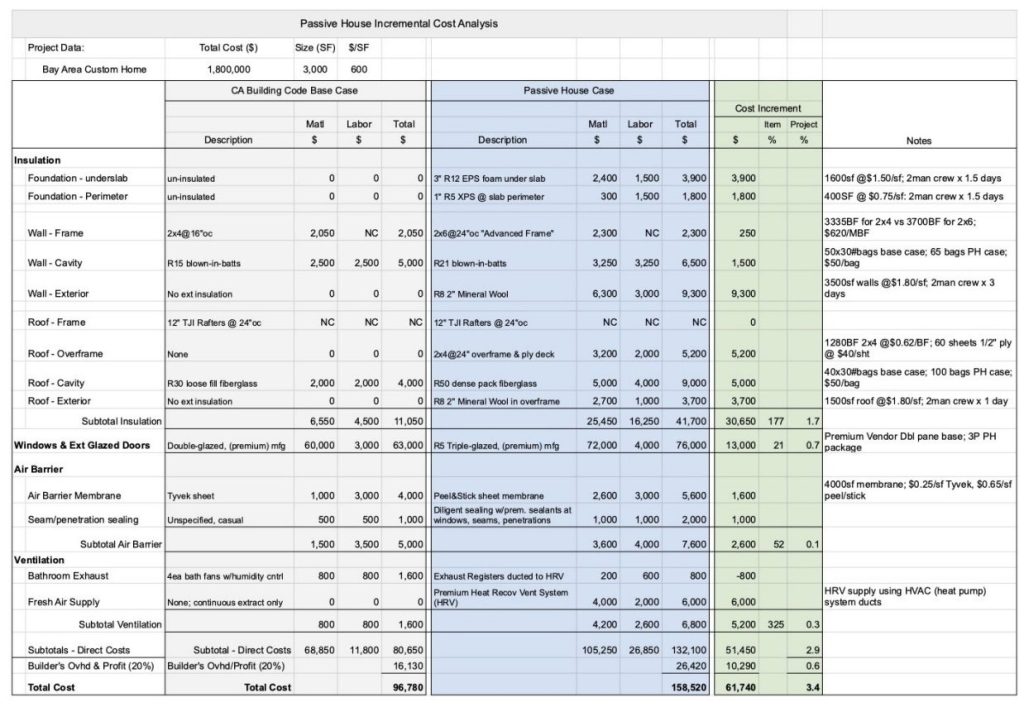
Conclusion
There is a lot of added value derived from easy upgrades to just four basic building components and a 3.5 to 4% increment to project cost. We have been doing this at One Sky Homes for over a decade, and wouldn’t think of building anything other than a Passive House.
Allen Gilliland III, One Sky Homes
Related Posts:
Is Cost the Barrier to Passive House Performance?
Get Trained:
Introductory Training Options
Core Certification Training Options
Specialized Training Options

